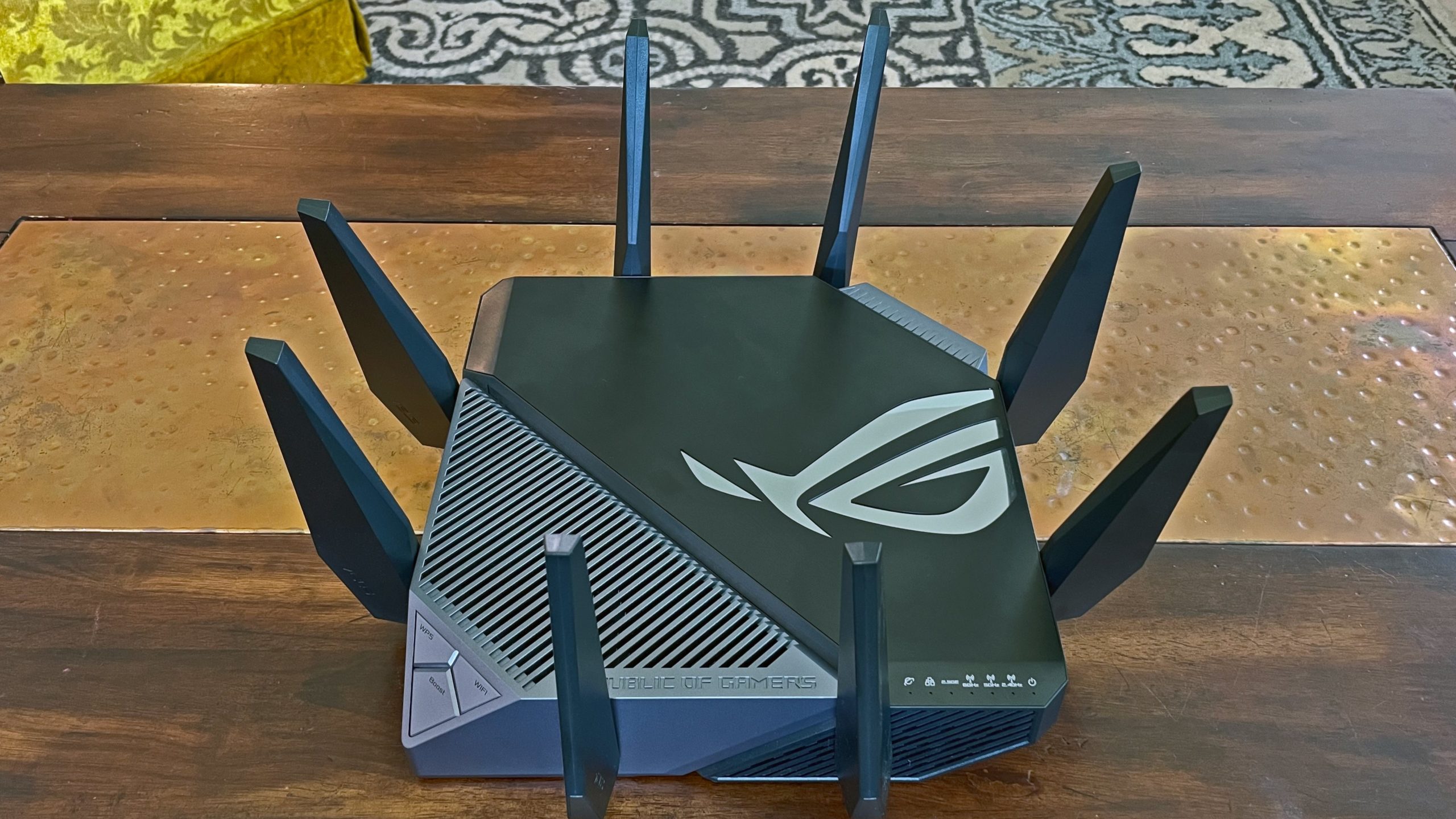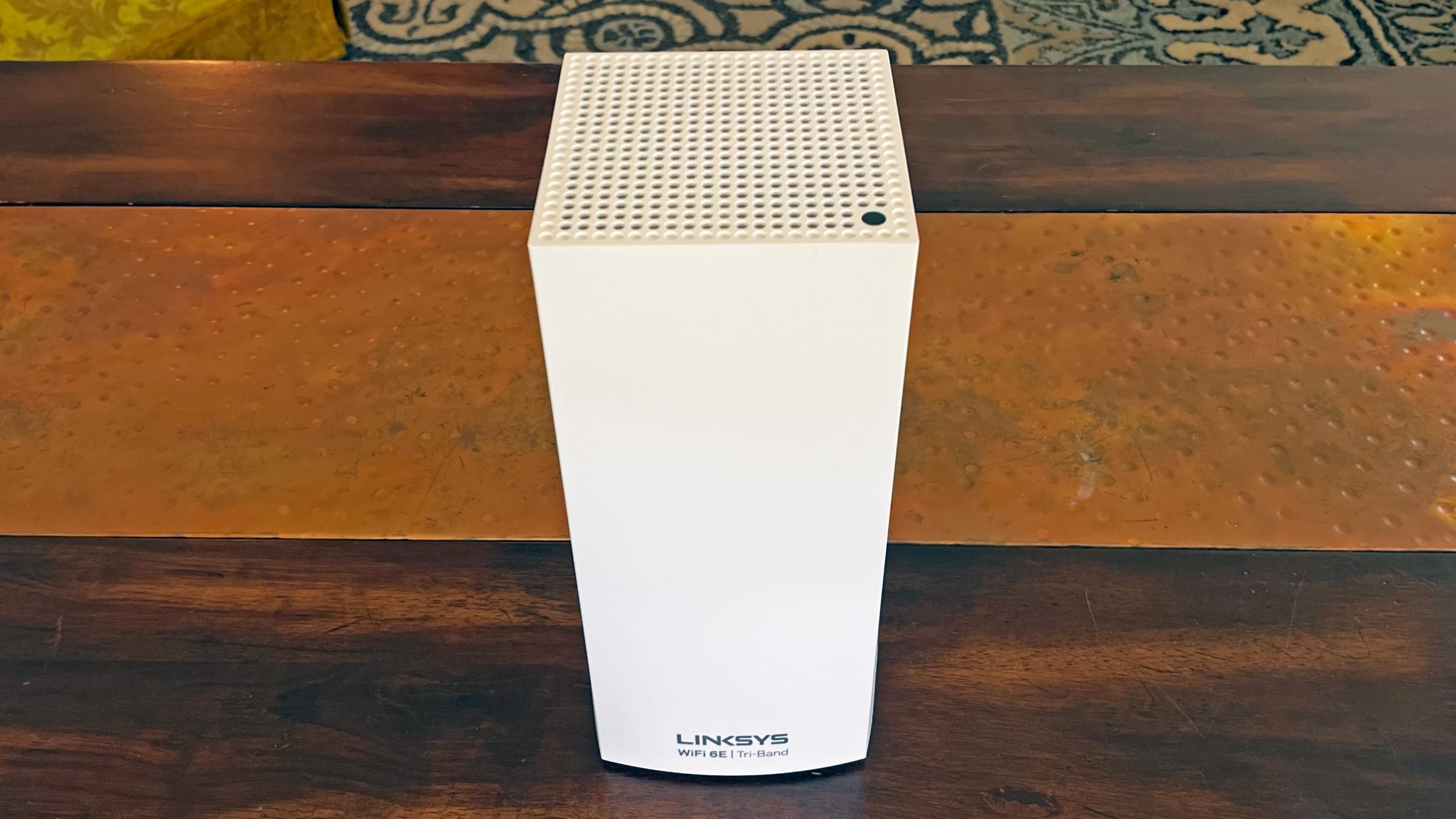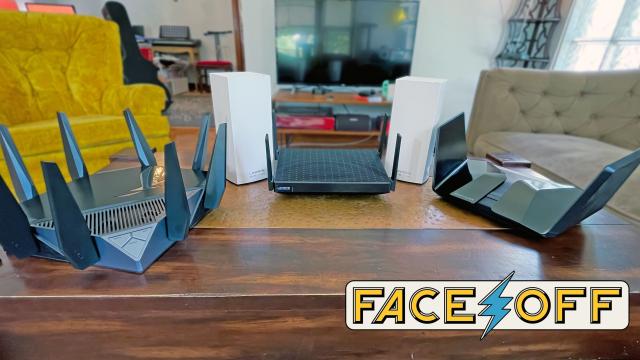Given how new and expensive Wi-Fi 6E routers are right now, is it even remotely reasonable for you to buy one? You’ll have to search your own heart for the answer to that question, but you’re here, so I’m going to help you figure out which one is best. Over the last couple of months, I’ve looked at four different Wi-Fi 6E routers, comparing their features, performance, ease of use, and, yes, looks. These are the ones I tested:
Linksys Atlas Max 6E Mesh System ($US1,199 ($1,538))
Linksys Hydra Pro 6E ($US499 ($640))
Asus ROG Rapture GT-AXE11000 ($US549 ($704))
Netgear Nighthawk RAXE500 ($US600 ($770))
Pardon, Friend, What Is Wi-Fi 6E?
You may be thinking something like, “Hey, didn’t we just start getting Wi-Fi 6 stuff?” Well, yes. We’ve only been on that standard for about three years, and devices only really started supporting it broadly around the end of 2019. Don’t worry about throwing out all your stuff just yet, however: Wi-Fi 6E is not exactly brand new. Think of it more like an expansion of Wi-Fi 6. See, until recently, Wi-Fi couldn’t operate above the 5 Ghz band, but that all changed in mid-2020 when the FCC opened up the 6 GHz band to unlicensed use. From this regulatory change springs our new standard: Wi-Fi 6E is simply Wi-Fi 6 operating in the pristine, unpolluted pastures of the 6 GHz band. For a more in-depth explainer, check out Gizmodo’s explainer here. Now, let’s talk about the nitty and the gritty.

The Fastest Wi-Fi 6E Router
A Wi-Fi 6E router shouldn’t just have good performance — not at the prices they’re charging for these things, which start at $US500 ($641). It should be mind-blowing. And, with the right equipment connected, all four of the routers I tested were fast. However, two of them proved astounding: the Netgear Nighthawk RAXE500 and the Asus ROG Rapture GT-AXE11000. Both routers, when tested with the 6E-capable Samsung Galaxy S21 Ultra, were so fast that I found myself in disbelief, double-checking the conditions I’d entered into network-testing software iperf 3 to make sure I hadn’t screwed something up. But it wasn’t their Wi-Fi 6E speed that I was so shocked by; it was the Wi-Fi 6 speed on the old 5 GHz network that really got me. I knew the speeds I was seeing — which were between 1.4 and 1.9 Gbps — were possible with Wi-Fi 6, but this was the first time I’d actually seen that play out.

OK, great, but which of these two was the best in terms of raw performance? It’s very close. The two routers had nearly identical performance up close, except the Netgear’s Wi-Fi 6E speed dropped pretty dramatically at around 25 feet (of course, it was still exceeding 600 Mbps at that distance). I got good speeds throughout my house, with an expected significant drop outdoors; neither did particularly well about 13.72 m out, thanks to multiple thick walls between the routers and the spot I chose to test them from. Neither could get a 6 GHz signal out there, but I was still connecting to the 5 GHz band and getting between 30 and 40 Mbps with either router. The major differences came when testing the ageing Wi-Fi 5 (324.60 ha) protocol, which only operates on 2.4 and 5 GHz bands. While the Netgear was a tad slower at closer ranges than the Asus, when I moved about 13.72 m away, outside, that same router was still pushing enough data for 4k streaming at an average 51.17 Mbps, while the Asus was almost unusable, barely managing 7.5 Mbps average.
Overall, it looks like Asus chose to prioritise faster speed at a closer range in general than the Netgear, which feels geared more towards a more than fast enough connection spread over a broad area. I was tempted to give the Netgear Nighthawk RAXE500 the nod because it performed slightly better in online gaming (about 5-10 ms lower ping across the board), but really, the difference was so minimal as to be inconsequential. Ultimately, the winner here depends on your priorities: if you want more stability over slightly broader coverage, the Netgear is your go-to, but if you’d rather a router with greater throughput at closer range, pick the Asus. That’s right, partner: this one is a tie.
Winner: Tie between Netgear Nighthawk RAXE500 and Asus ROG Rapture GT-AXE11000
The Best-Performing Wi-Fi 6E Router
Astounding speed is great, but it’s no good if the router doesn’t perform well overall. That means high throughput, sure, but it also means stability, good coverage, and seamless operation. In short, the best routers are ones that disappear into the background of your life. So which of these routers does this the best?
For a Wi-Fi standard that heavily promotes its ability to deal with a great many connected smart home devices, I’ve had some pretty miserable experiences with Wi-Fi 6. I confess I didn’t have high hopes with this batch of routers using essentially the same standard, just extended to a new band. But each of these routers did very well, with the initial exception of the Asus ROG Rapture GT-AXE11000. To that router’s credit, though, things seem to have changed with subsequent firmware updates — it was a far more agreeable experience when I re-tested for this face-off (although I still have issues with its UI and physical footprint). Gaming was more than acceptable with all of the routers, and none of them blinked at high-bandwidth activity across the network. In fact, the only significant differentiator I found, as far as general performance goes, was in functional range.
At a distance, the only routers that really pushed a usable signal to a point about 13.72 m in my back yard were the Netgear Nighthawk RAXE500 and the Linksys Atlas Max 6E. Unfortunately for the Linksys router, the only way it could match the Nighthawk for speed at that range was by bouncing the signal with a second node — a feat that I’m not sure is really worth the extra $US400 ($513) it costs for the 2-pack. If you ran an ethernet drop to that second node, of course you could get amazing speed at that distance, but for most people, I’m going to say the Nighthawk wins this round.
Winner: Netgear Nighthawk RAXE500
The Best-Looking Wi-Fi 6E Router
Whether or not a router has an appealing design has no bearing on its performance, but router manufacturers pay people (presumably) good money to craft their appearance and physical dimensions, so we’re going to evaluate it.
The four routers I looked at basically couldn’t look any more different from each other, but that doesn’t mean I can’t tell you which one is my favourite to look at or set up on my desk. I’ll be honest, I thought when I was waiting for these routers that I would just hate the Asus straightaway. By all rights, I definitely should: the chunky antennas, utter lack of symmetry, and the tacky, blazing ROG logo that looks like it came out of the margins of a middle schooler’s notebook should all be the visual equivalent of nails on a chalkboard to my typically more minimalist sensibilities. But then, I used to wear puffy Cowboys Starter jackets and these very silly Wayne Gretzky Street Hockey shoes. I guess I shouldn’t be surprised, then, that part of me — the part that still plays and enjoys Counter Strike, no doubt — actually likes the look of the ROG Rapture GT-AXE11000.

In a much tamer interpretation of the flat-thing-with-movable-antennas look, the Hydra Pro 6E shows a bit more class, giving up any pretense at grabbing your attention. It’s not ugly, and it ain’t beautiful; it’s just a fine-looking router.
The Netgear Nighthawk RAXE500, like the Asus, also features a sort of isn’t-this-cool design, but is more sleek and futuristic than the more industrial GT-AXE11000. It’s more than a little evocative of the First Order Command Shuttle, with folding, vertical wings that contain the antennas, which would otherwise jut from the sides.

Still, routers as big as these annoy me, which is why here I gave the nod to the Linksys Atlas Max 6E Mesh System. It’s not that I especially like the designer trash can look. I’m just very into tech like this recognising that there is often more vertical space than horizontal on a desk or a shelf. Now if only Linksys would let me turn off that far-too-bright status LED on top…
Winner: Linksys Atlas Max
The Easiest Wi-Fi 6E Router to Use
All of the routers here let you perform setup easily, with a handy smartphone app that essentially does everything for you. Still, peoples’ network needs are varied, and at some point, most people will need to actually manage their network. Whether it’s just to toggle their guest network, set a preferred DNS, or change which band uses which wireless protocols, these things should be generally easy to find and understand. The three GUI styles of the Linksys, Asus, and Netgear routers seemed to run the gamut of what you can expect from a router’s management software.
On one end, the Asus ROG Rapture is deeply customisable, but any average person is going to find it head-swimmingly confusing to manage. The organisation of features is confusing, with options that should be front and centre buried inexplicably under “Advanced Settings,” while AiMesh, which most people probably aren’t going to use, is given top billing in the menu hierarchy. That said, if you like having unfettered control of your router, Asus is the leader here, with many devoted fans as a result.
On the other end sits Linksys. Their Hydra Pro and Atlas Max routers share a common interface that is straightforward, but it’s also pretty lean when it comes to configurability. It’s far from useless, but it definitely doesn’t feel like you’re looking at the UI of a router that costs, on the low end, hundreds of dollars.
It was Netgear that struck the right balance here. The RAXE500’s interface is approachable and easy to understand, while still offering robust control for those who want it, tucked away in the menu so as not to scare off novice users the moment they log into the management software. It also has nice at-a-glance information on its default screen, and the smartphone app isn’t the hamstrung experience it can sometimes be. It also has network-level security features that Linksys currently lacks, but which are increasingly offered on more and more Wi-Fi routers – in this case it’s called Netgear Armour, and it’s $US70 ($90)/year. For that you get a VPN, ad-blocking and malware-blocking, and client device scanning, all provided by Bitdefender. It’s a little pricier than other manufacturers’ offerings (Asus’ AiProtection is available for free, for example), but it’s a little more configurable and transparent than other options.
Winner: Netgear Nighthawk RAXE500
The Best Wi-Fi 6E Router
Picking the best Wi-Fi 6E router isn’t just about getting the fastest 6 GHz performance (although that certainly doesn’t hurt!); precious few client devices are capable of even living on that band, and there is no software update in the world that will let your phone or computer use it. So if you’re considering upgrading now, you’re going to want something that’s also a great Wi-Fi 6, and even Wi-Fi 5, router. Cheap isn’t an option here: At a minimum $US500 ($641), these routers are upsettingly expensive. But at that price, you should expect thoughtful management software that is intuitive and approachable, while still giving you access to powerful troubleshooting tools. That price should also offer a solid network security experience.
At the moment, these routers are all still changing. One can presume they were all somewhat rushed to market in an attempt to make sure they were there the firstest with the mostest. As a result, their feature set is not concrete and will be updated in coming months with more features. Linksys, for example, seems the most barren when it comes to advanced features, but in conversations with a representative there, we can expect HomeKit compatibility and Linksys Shield/Linksys Aware features down the line. Features like this and others pushed out later could absolutely change my opinion on the best router overall if I retested and updated this in, say, six months.
That said, with the exception of the Hydra Pro, which I believe struggled to really find its place in this tier and should probably be priced a bit below where it is, all of the routers I looked at were excellent in their own right. It was the Netgear Nighthawk RAXE500 that gave the best showing. Its staggeringly high-bandwidth throughput, stability, and range, combined with easy-to-use software, robust security, and slick appearance, gave it the edge over the others in this face-off. As things stand now, it felt the most complete, and I feel it will probably stand up well against the others as they add features and performance tweaks over in the coming months.
